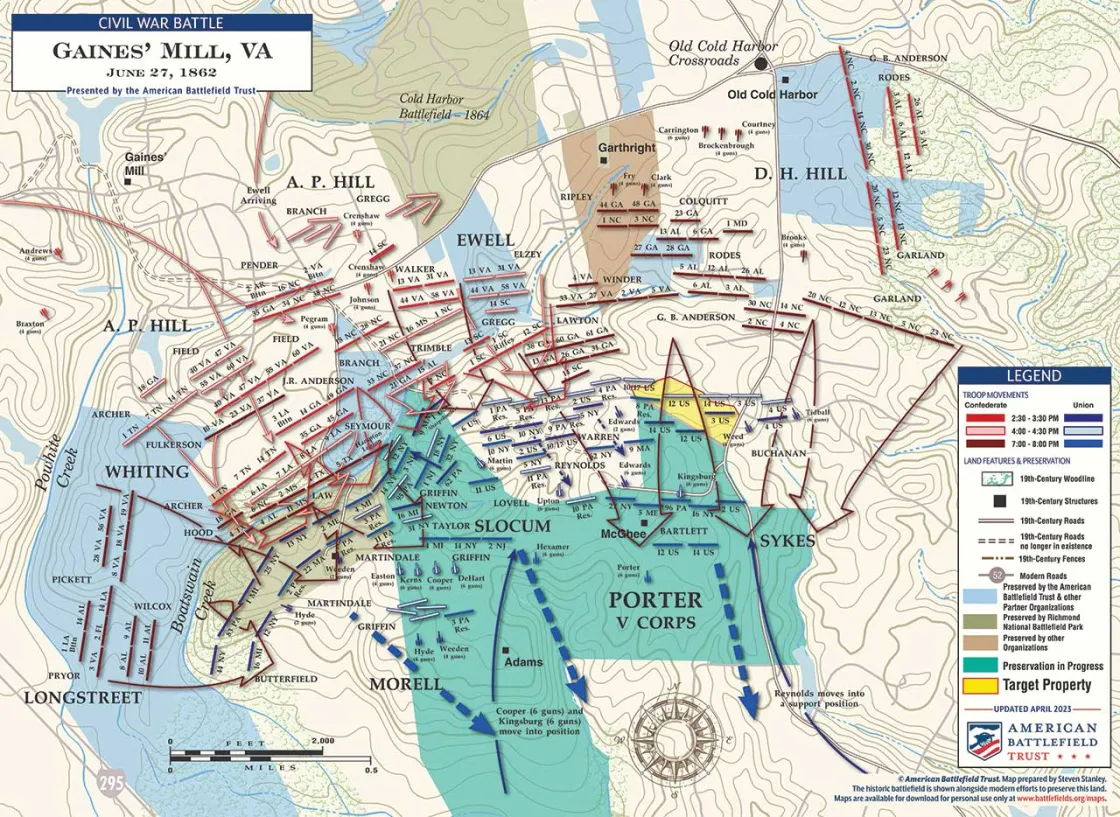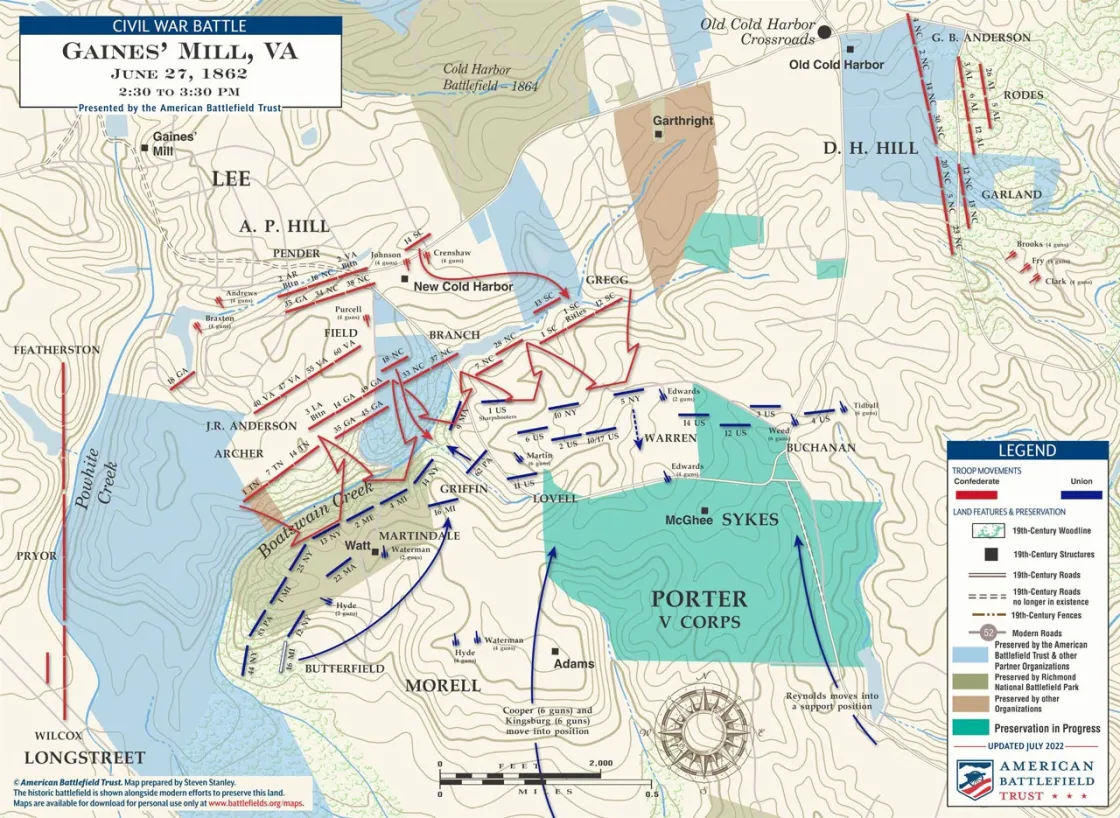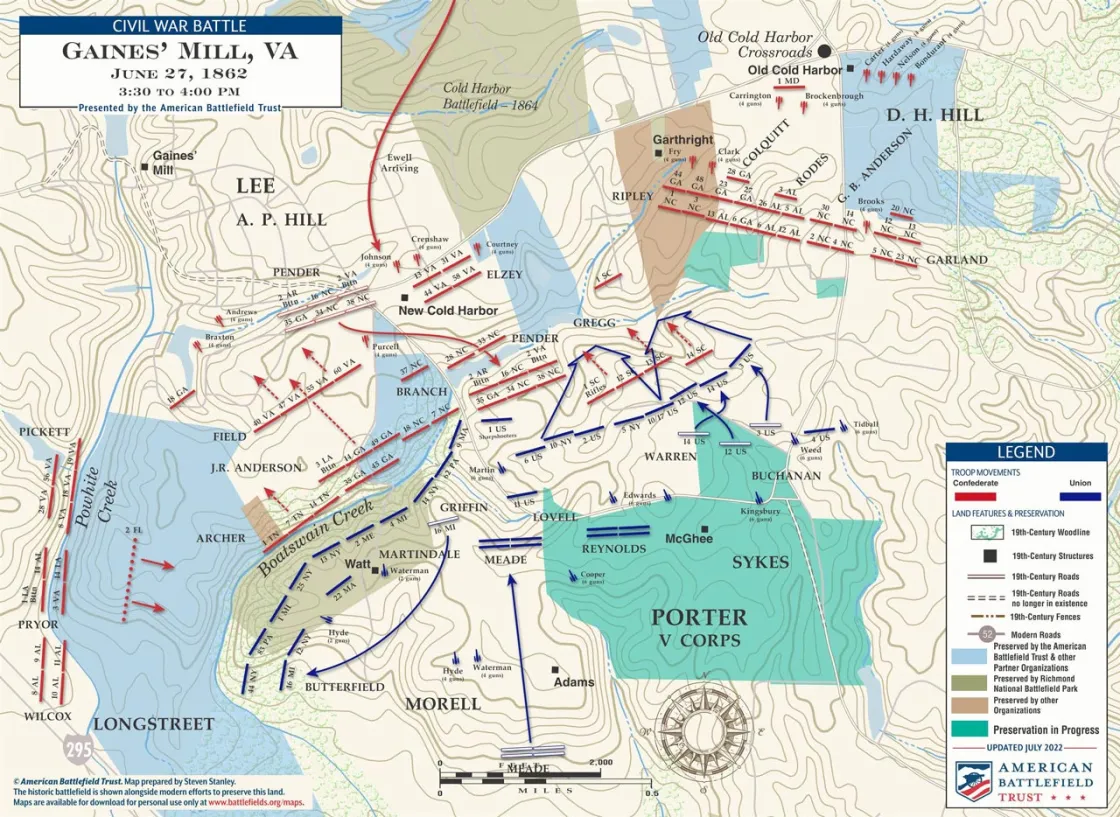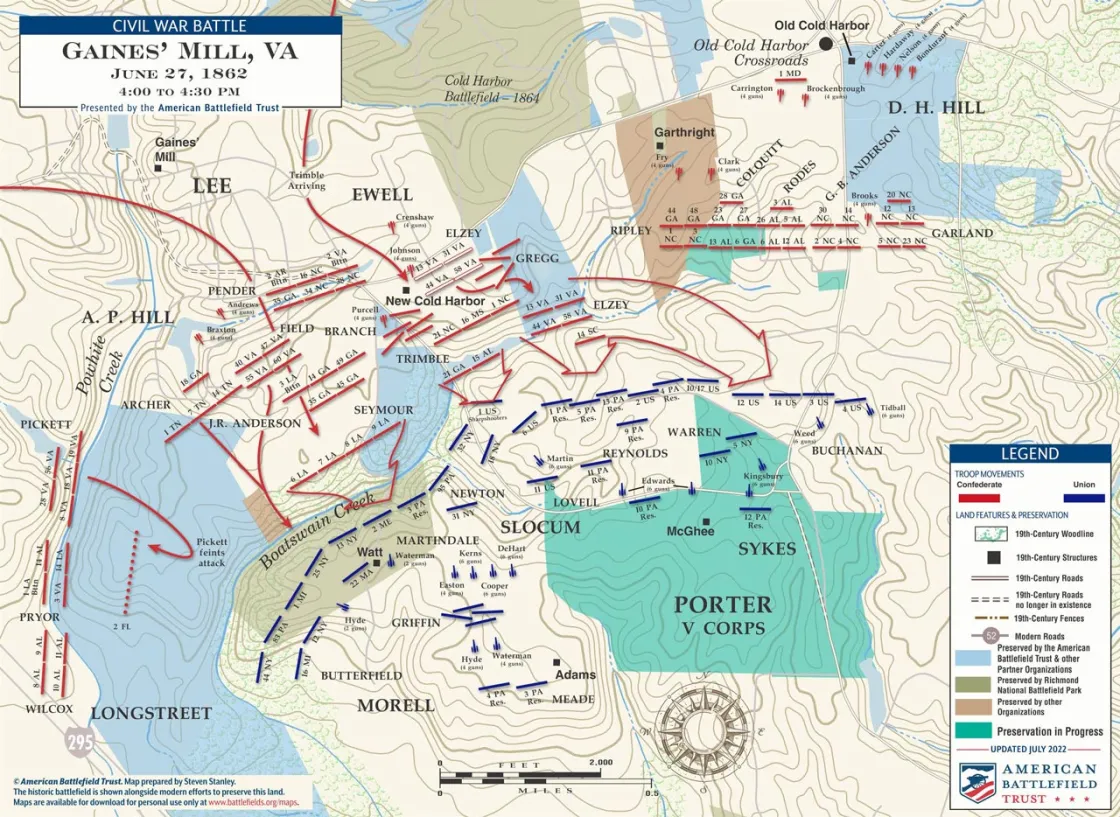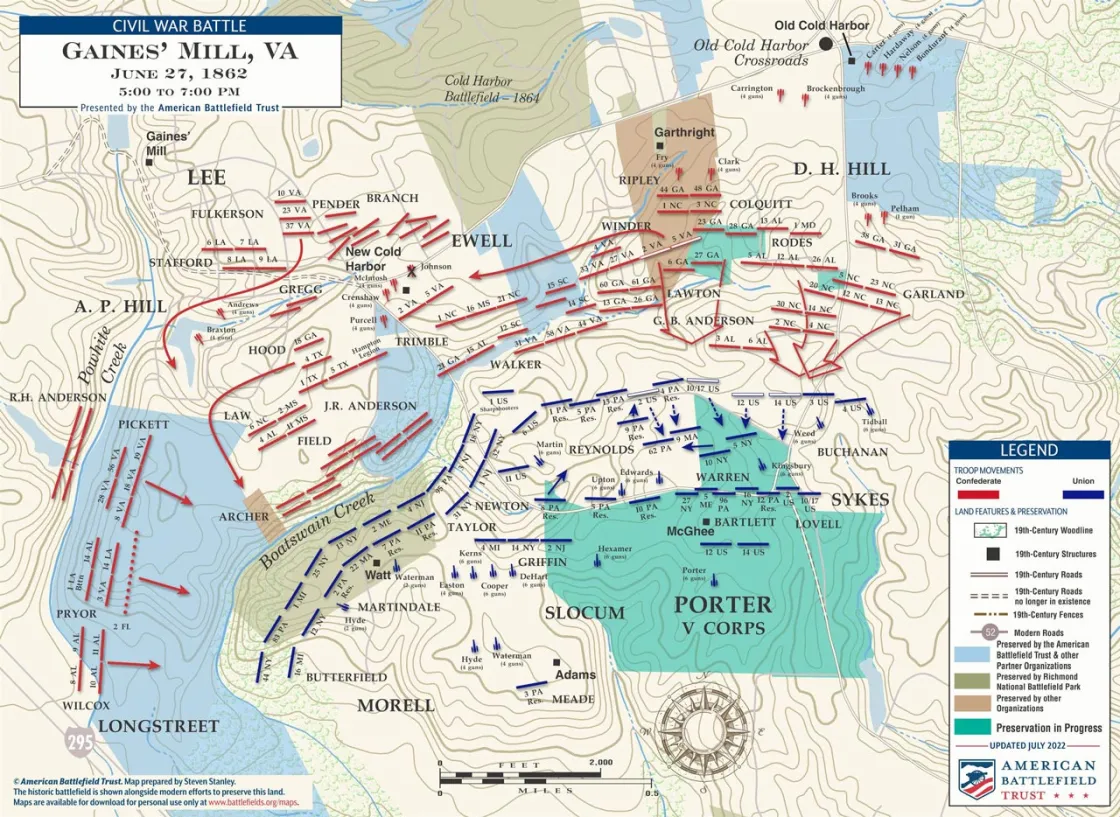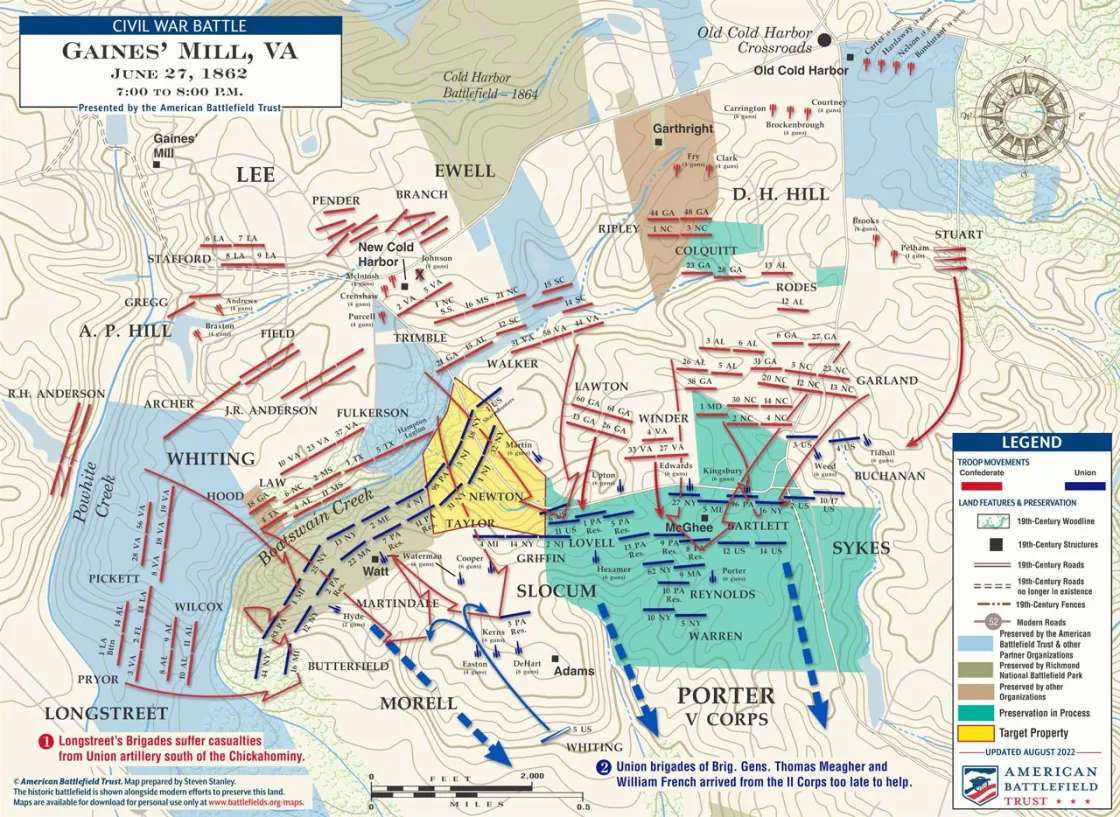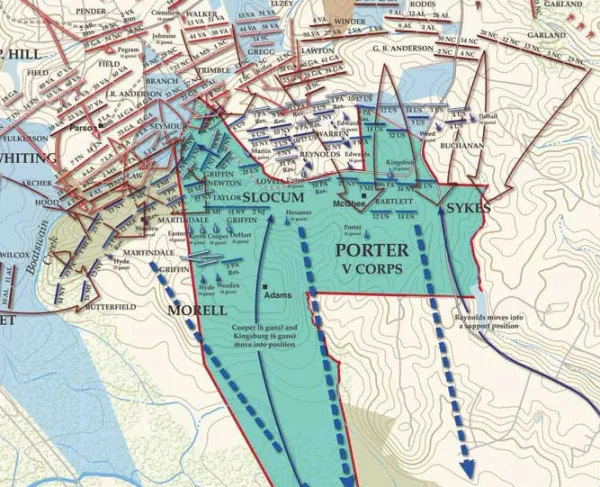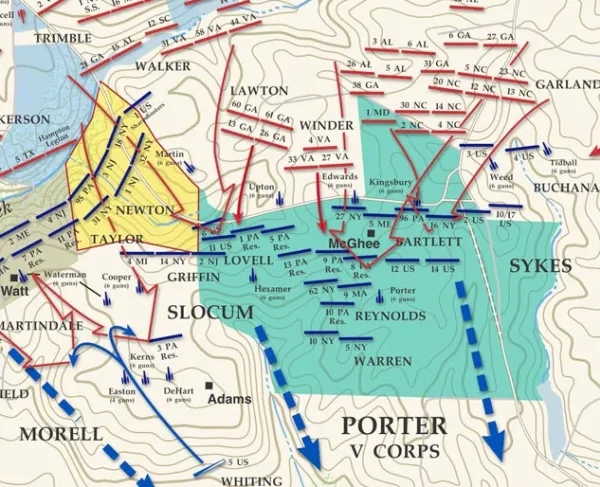Gaines' Mill | June 27, 1862
Overview
In the early hours of June 27, 1862, Maj. Gen. Fitz John Porter’s Union V Corps abandoned their position at Beaver Dam Creek and established a new defensive line behind Boatswain’s Swamp, just north of the Chickahominy River. During the afternoon, the Federals beat back successive waves of disjointed Southern attacks, inflicting some of the heaviest casualties of the war up to this point. By dusk, however, Gen. Robert E. Lee’s Confederates were better organized. The divisions of Maj. Gens. Richard S. Ewell and D. H. Hill from Maj. Gen. Thomas J. “Stonewall” Jackson’s wing supported the Confederate center and left while Maj. Gen. James Longstreet attacked on the Confederate right. With daylight fading, the reinforced Southerners assaulted Porter’s line and sent the Northerners fleeing toward the river. The defeat at Gaines’ Mill convinced Maj. Gen. George B. McClellan to abandon the campaign against Richmond and “change his base” of operations to the James River.
2:30 - 3:30 pm
The earliest Confederate attacks at Gaines’ Mill were by fresh troops from Maj. Gen. A. P. Hill’s division, who had not participated in the attacks the day before along Beaver Dam Creek. The North Carolina brigade of Brig. Gen. Lawrence O’Bryan Branch struck the Federal position near its center, where the V Corps brigade of Brig. Gen. Charles Griffin held the line. The Yankees held the high open ground south of the creek, and the wooded ground in their front is locally known as Griffin’s Woods. Georgia and Tennessee regiments under Brig. Gens. J. R. Anderson and James Archer also advanced through the woods. Infantry and artillery fire from Griffin’s regiments and batteries, as well as the thick vegetation and swamps of Boatswain’s Creek, prevented the Southerners from gaining any ground. Later in the afternoon, Maj. Gen. Richard S. Ewell’s division attacked over the same terrain.
3:30 - 4:00 pm
Major General A. P. Hill's assault on the Federal position near Gaines' Mill grew in strength and intensity by 3:30 pm. As Hill's men descending one side of the Boatswain's Creek valley, they were subjected to smalls arms and artillery fire from the Union soldiers, who assumed a stong tree-line deep position overlooking the south bank of the creek. On Hill's right, the brigades of Generals Charles W. Field, James J. Archer, and Joseph R. Anderson were stopped by the Federals and then driven back. On Hill's left, he attempted to fill a gap between Maxy Gregg's South Carolina brigade and the rest of his division with the brigade of W. Dorsey Pender. A Federal counterattack by the brigades of Charles Lovell, Robert S. Buchannan, and Gouverneur K. Warren inflicted heavy casualties on Gregg's men, driving the Palmetto troops back toward New Cold Harbor. The ill-coordinated Confederate assault on the Federal V Corps line proved futile. Southern reinforcements and better coordination would be needed to dislodge Maj. Gen. Fitz John Porter and his men from their strong position along Boatswain's Creek.
4:00 - 5:00 pm
By 4:00 p.m., Maj. Gen. Thomas J. “Stonewall” Jackson’s brigades began arriving on the battlefield. The division of Maj. Gen. D. H. Hill filled in the Confederate left near the Old Cold Harbor Crossroads, while Jackson sent the division of Maj. Gen. Richard S. Ewell to the left of A. P. Hill’s division, who had already tried their hand at assaulting the Federal line along Boatswain's Creek and was losing momentum. The Confederate attacks between A. P. Hill and Jackson were not well-coordinated, and were repulsed with the help of Yankee artillery fire from the open farms of the Adams and Watt families to the south. As the Confederates massed for their assaults, the VI Corps division of Maj. Gen. Henry W. Slocum was sent across the Chickahominy to support the V Corps.
After hours of fruitless and ill-coordinated assaults on the Union V Corps line along Boatswain's Creek, the Confederate high command was finally able to start working as a team. Major General A. P. Hill's division bore the brunt of the late afternoon fighting, now Gen. Robert E. Lee brought the forces of Maj. Gens. James Longstreet, Thomas J. Jackson, Richard S. Ewell, and D. H. Hill to bear on the Union line. Lee's assault force numbered some 42,000 men—making it the largest single assault of the entire Civil War.
Hill and Ewell struck the Federal right and center respectively. The overwhelming number of Rebel troops drove back the Federal right flank. On the Union left, James Longstreet's men wrapped around the Yankee flank. The assault sent the Northerners fleeing toward the Chickahominy River. During the night, the Federals limped across the river and burned the bridges behind them. Gaines’ Mill was the third in the Seven Days Battles and initiated a series of rearguard actions as Maj. Gen. George B. McClellan moved his army to the safety of the James River—handing over the strategic initiative of the Seven Days Campaign to Robert E. Lee.
7:00 - 8:00 pm
Around dusk, Gen. Robert E. Lee ordered an all-out attack all along the Confederate line, which now included the division of Maj. Gen. James Longstreet on the right. Lee ordered forward around 32,000 men in 16 brigades, his largest attack of the war. They moved forward individually rather than in one solid blow; some were repulsed in small unit actions. Porter had around 34,000 men, including reinforcements, and had many more artillery batteries than the Rebels. The first Confederates to pierce the Federal line were the Texas regiments of Brig. Gen. John B. Hood along Boatswain’s Creek. As night fell, Porter’s men fell back south of the Chickahominy River.
After 25 years, the American Battlefield Trust is in the final stretch of one of the most ambitious preservation campaigns in its history. Every gift...
Related Battles
6,800
8,700
